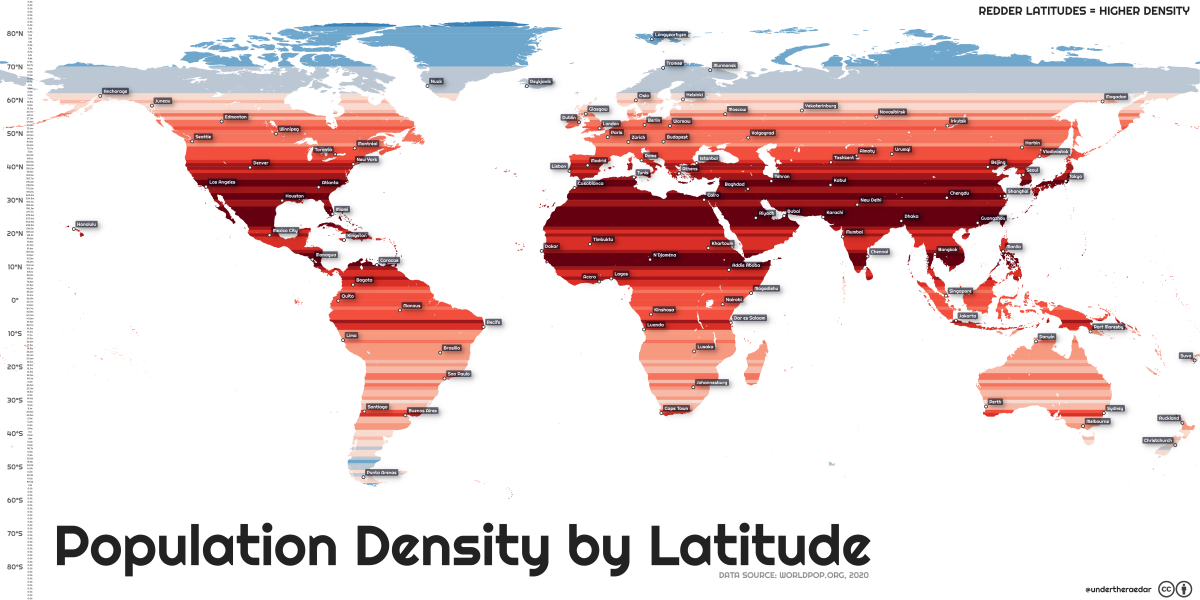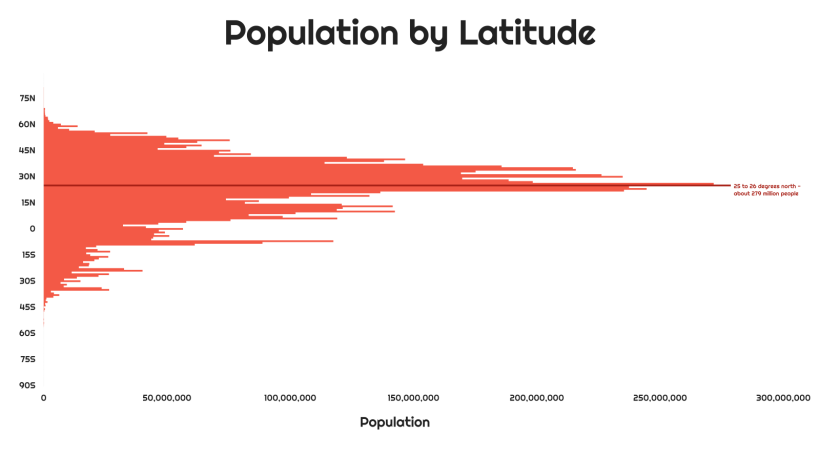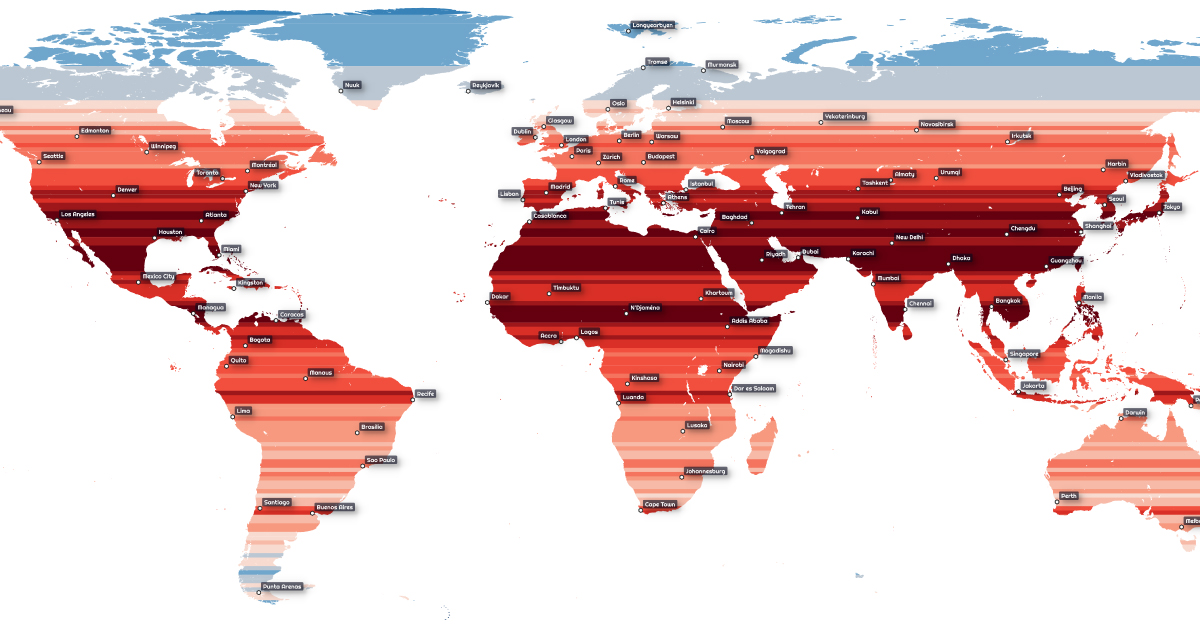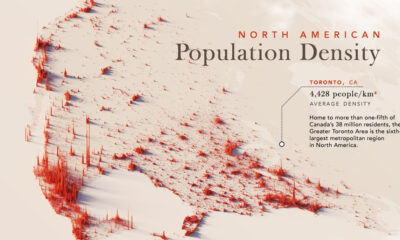Demographics
Mapped: The World’s Population Density by Latitude
Click to view a larger version of the graphic.
Mapped: The World’s Population Density by Latitude
When you think about areas with high population densities, certain regions spring to mind. This could be a populous part of Asia or a cluster of cities in North America or Europe.
Usually density comparisons are made using cities or countries, but this map from Alasdair Rae provides another perspective. This world map depicts population density by latitude, going from the densest populated coordinates in deep red to the sparsest in light blue.
Why Certain Latitudes (and Regions) Are More Densely Populated
Numerous factors affect an area’s population density. These can range from topography, or the physical terrain characteristics of the place, to more direct factors like an area’s climate, which can impact both the survivability and agricultural potential.
Political, economic, and social factors are also at play—for example, there is a natural lack of livelihood opportunities in sparse areas such as the Amazon rainforest or the Himalayas.
Breaking down the population by latitude, we see the population becomes more concentrated near the equator. In particular, the 25th and 26th parallel north are the most densely populated latitude circles. Around 279 million people reside in these latitude lines, which run through large countries like India, Pakistan, Bangladesh, China, the United States, Mexico, and others.
Despite their large landmasses, many of these countries do not themselves have very high population densities. Since density measures the ratio of people to physical space, countries with vast but sparse regions like China and India are less dense than imagined.
Out of the top 10 most densely populated countries in the world, only a couple can be found on the 25th and 26th parallel north—Bangladesh and Bahrain. For a size comparison, Bangladesh is 1.55% the size of China, and Bahrain is only 0.01%.
The Future of Population Density Near the Equator
Looking ahead to 2100, the UN projects that the global population will rise to almost 11 billion. This would increase global population density from 59.11 people per square kilometer in 2022 to 80.82 per square kilometer in 2100.
However, the projections show that Asia will not be the biggest contributor to this growth. Instead, the most considerable jump in population is predicted for Africa, set to grow by almost 200% from almost 1.5 billion people today to 4.3 billion in 2100.
The equator runs right through the middle of Africa and crisscrosses countries like the Congo (both the Republic and DRC), Kenya, Gabon, Uganda, and Somalia.
As Africa’s population expands, this means that at latitudes near the equator, there could be even higher population densities coming. Or course, this largely depends on how the world’s fastest growing cities—most of which are in Africa—shape up over the coming decades.

This article was published as a part of Visual Capitalist's Creator Program, which features data-driven visuals from some of our favorite Creators around the world.
Demographics
The Smallest Gender Wage Gaps in OECD Countries
Which OECD countries have the smallest gender wage gaps? We look at the 10 countries with gaps lower than the average.
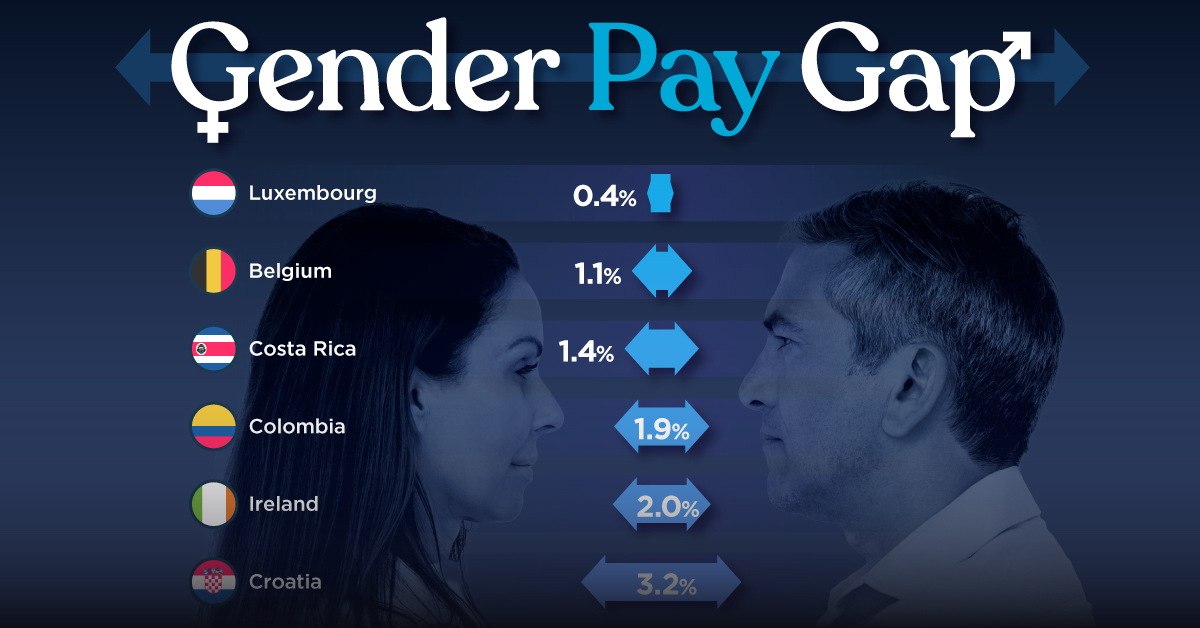
The Smallest Gender Pay Gaps in OECD Countries
This was originally posted on our Voronoi app. Download the app for free on iOS or Android and discover incredible data-driven charts from a variety of trusted sources.
Among the 38 member countries in the Organization for Economic Cooperation and Development (OECD), several have made significant strides in addressing income inequality between men and women.
In this graphic we’ve ranked the OECD countries with the 10 smallest gender pay gaps, using the latest data from the OECD for 2022.
The gender pay gap is calculated as the difference between median full-time earnings for men and women divided by the median full-time earnings of men.
Which Countries Have the Smallest Gender Pay Gaps?
Luxembourg’s gender pay gap is the lowest among OECD members at only 0.4%—well below the OECD average of 11.6%.
| Rank | Country | Percentage Difference in Men's & Women's Full-time Earnings |
|---|---|---|
| 1 | 🇱🇺 Luxembourg | 0.4% |
| 2 | 🇧🇪 Belgium | 1.1% |
| 3 | 🇨🇷 Costa Rica | 1.4% |
| 4 | 🇨🇴 Colombia | 1.9% |
| 5 | 🇮🇪 Ireland | 2.0% |
| 6 | 🇭🇷 Croatia | 3.2% |
| 7 | 🇮🇹 Italy | 3.3% |
| 8 | 🇳🇴 Norway | 4.5% |
| 9 | 🇩🇰 Denmark | 5.8% |
| 10 | 🇵🇹 Portugal | 6.1% |
| OECD Average | 11.6% |
Notably, eight of the top 10 countries with the smallest gender pay gaps are located in Europe, as labor equality laws designed to target gender differences have begun to pay off.
The two other countries that made the list were Costa Rica (1.4%) and Colombia (1.9%), which came in third and fourth place, respectively.
How Did Luxembourg (Nearly) Eliminate its Gender Wage Gap?
Luxembourg’s virtually-non-existent gender wage gap in 2020 can be traced back to its diligent efforts to prioritize equal pay. Since 2016, firms that have not complied with the Labor Code’s equal pay laws have been subjected to penalizing fines ranging from €251 to €25,000.
Higher female education rates also contribute to the diminishing pay gap, with Luxembourg tied for first in the educational attainment rankings of the World Economic Forum’s Global Gender Gap Index Report for 2023.
See More Graphics about Demographics and Money
While these 10 countries are well below the OECD’s average gender pay gap of 11.6%, many OECD member countries including the U.S. are significantly above the average. To see the full list of the top 10 OECD countries with the largest gender pay gaps, check out this visualization.
-

 Real Estate2 weeks ago
Real Estate2 weeks agoVisualizing America’s Shortage of Affordable Homes
-

 Technology1 week ago
Technology1 week agoRanked: Semiconductor Companies by Industry Revenue Share
-

 Money1 week ago
Money1 week agoWhich States Have the Highest Minimum Wage in America?
-

 Real Estate1 week ago
Real Estate1 week agoRanked: The Most Valuable Housing Markets in America
-

 Business2 weeks ago
Business2 weeks agoCharted: Big Four Market Share by S&P 500 Audits
-

 AI2 weeks ago
AI2 weeks agoThe Stock Performance of U.S. Chipmakers So Far in 2024
-

 Misc2 weeks ago
Misc2 weeks agoAlmost Every EV Stock is Down After Q1 2024
-

 Money2 weeks ago
Money2 weeks agoWhere Does One U.S. Tax Dollar Go?

